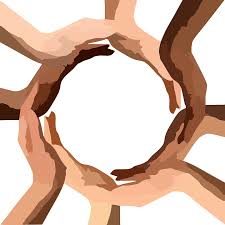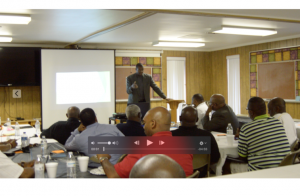
 We welcome Dr. David Campt to the CELE blog. David lives near Eden, NC and works across the U.S. on many community engagement projects.
We welcome Dr. David Campt to the CELE blog. David lives near Eden, NC and works across the U.S. on many community engagement projects.
This article is the second in a two-part series that reflects my experiences in designing and facilitating meetings on police-community relations. Part 1 reviewed a meeting were a group of black ministers were thinking over their options for what kind of meeting they might want to have and who might be invited. This article (Part 2) will review my approach to dialogic meeting design, including some specifics about ways to ask and sequence questions to foster engagement and empathy.
While it is certainly possible to pursue multiple goals in the same meeting – and thus use multiple modes – there are cases where it makes more sense to narrow the goals of any particular meeting. What is most important is that the meeting designer and convener push themselves to clarify their objectives. For the sake of this discussion, I will focus on a meeting that is designed to focus on building empathy between white civilians and civilians of color. Thus, the examples provided will assume that police officers are not present in the meeting. The general approach to meeting design has been useful when police have been present.
Core Dialogue Model
My approach to designing meeting reflects some concepts about meeting design that come from the book entitled The Little Book of Dialogue for Difficult Subjects (Schirch, Campt 2007). This book posits that effective dialogues often include four phases that often occur in the following order:
Phase 1: Establishing the participants’ common intention
Phase 2: Exploring participant’s similar and different experiences
Phase 3: Probing the reasons why people’s experiences are similar and different
Phase 4: Examining what, if anything, might the participants agree needs to be done
Let’s look at how a meeting designer/facilitator might plan for a meeting using this framework.
Phase 1: Establish common intention
Primary design objective: helping people see that others’ motivations are positive and potentially compatible with their own.
The core challenge is the formulate a question about intention that helps each person connect with what feels like a core motivation for them, and do so in a way that will likely produce a sense of compatibility and alignment with others. A simple formulation of such a question might be:
Why did you come to the meeting tonight?
Or
What is your motivation for spending some of your evening at this meeting?
While these phrasings have the benefit of simplicity, they also contain some risk that people with different motivations may express themselves in ways that appear oppositional from the start. It is not difficult to imaging a white person who tends to strongly favor police saying something like, “I came here because I think the police get bashed to much and I want to make sure that this community conversation has some folks who will defend the police who are so important to safety.” Conversely, a person of color concerned about police brutality might answer the question with “I came because police in this town get away with too much brutality against black people that did not do anything and I want to speak about it and stop it.” While a good facilitator might remind people that one can be concerned about police safety and police brutality, such expressions of intention might be perceived by participants has oppositional; thus these articulations put these participants on opposite sides of a conflict at the very start of their dialogue.
One way to lessen the risk of initial statements of motivation causing such a perceived dichotomy is to ask the same question in a way that is more complex, but nudges the participants to do a small bit of perspective taking from the outset. Here might be an alternative formulation:
We all come here for different reasons. Think about why you came here tonight. How would you express your motivation in a way that you think almost anyone would agree with?
With this formulation, both the theoretical white and black person from above might be pushed to a formulation that might be closer to; “I came here because I just want to push for more safety – for the police, for the community. We all need safety!”
The decision about how to phrase the motivation question and other aspects of managing Phase 1 should be made in consideration of a number of factors: the duration of the meeting, the vastness of differences in motivation that are likely to be present, the likelihood of the participants to express themselves in ways that are confrontive to others, the quality of facilitation, among other considerations.
Phase 2: Probing Similar and Different Experiences
Primary Design Objective: Helping participants see that their experience with the topic are one of a broader set of possibilities they do not always consider
If the duration of the meeting or the controversial tone in the community requires going directly to the issue without warm up, one way to frame the question that surfaces different experiences is:
Please share an experience that happened to you or someone you know well which illustrates the way that police and the community relate to each other.
A few points to note:
- The reason that this question asks about “you or your family” is because people are often deeply affected by experiences that happened to their family though not to themselves directly.
- Many people have experienced the recent nationally shared videos of community police interactions as very disturbing. While these experiences may play a role in the conversation at some point, events in other places are likely to be dismissed as irrelevant by people who are skeptical about the idea that police might treat some people differently than others.
- This formulation of the question also gives people who are primarily connected to a pro-police perspective to bring positive experiences to bear. It is useful for these experiences to be part of the context for the dialogue not just analytically, but also emotionally. People who are more focused on police abuse may not even know people who have positive interactions often, and confirmation bias may limit how significantly that take these experiences when they do hear them.
In a small- or medium-size diverse group, this framing is likely to allow people with variety of experiences to add their experiences to general awareness of the group. One factor to consider is the degree to which the setting might inhibit some people from expressing themselves, which might cause a distorted picture of police-community relations.
In settings with more than a handful of people, some method of polling the audience – especially anonymously – can be very valuable. Audience polling technology makes it possible for people to let the group know that some experiences are present without having to publicly summarize the experience in the entire group. One polling question that I have used to highlight that fact that people have vastly different experiences in police community disconnects is:
How many times in the last 7 years have you seen police behavior that you would describe as abusive?1) never 2) once or twice 3) few times 4) some times 5) many times?
Inevitably, there will be a diversity of answers on this question, and it is useful for the group to see this. With groups of 20 or more people and where the polling system has the ability to show cross-tabulations, a great deal of learning can be gained from the cross-tabs on this question. On more than one occasion, I have used the cross-tabs feature to cut this data by person “of color” versus “white” status. Each time, a much higher portion of POCs are have seen problematic behavior more frequently. This fact is sometimes experienced as a shock to some white people. It is noteworthy that asking such questions also reveals that some folks of color have not seen problematic police behavior, and that some white folks have seen significant amounts of it. This recognition is useful for folks on all sides of the issue to see.
Depending on the amount of time that you have, it may be useful to provide an on-ramp to this dialogue about current experiences. Specifically, I have found that asking people about formative experiences can often be very useful in building connections between people and in helping people see that the way that we experience incidents now might be shaped by things that happened long ago. For instance, a question about previous perspectives and experiences can help people see each others’ perspective in context.
How did you feel about police as a child, and why did you feel that way?
A question like this gives people a platform to talk about what their parents taught them about police, or about early experiences they had that might be formative. In one dialogue, one senior black men talk about being a child and seeing the police protecting the KKK as they marched though his town. This comment was helpful in helping the white people in the room expand their understanding of why some people of color might have had a lifetime of seeing the police that is does the opposite of protect and serve.
Phase 3: Probing the Reasons why People’s Experiences are Similar and Different
Primary Design Challenge: Help participants begin constructing a shared view of the social dynamics that explain why they are having similar and divergent experiences.
It is this phase of the dialogue that requires the most skill, since it is the sense making phase that involves getting the group to go from their set of experiences to perhaps re-examining aspects of their worldview. An example question that a facilitator might put to the group is:
What do you think is going on such that there are so many diverse experiences and perspectives about the police in the conversation?
The core challenge here is to try to construct a new shared perspective on police-community relations and not simply revert to explanations that invalidate or minimize each other’s point of view. This effort will be more likely successful if the Phase 2 conversation surfaced the fact that people from different groups often have a very different set of experiences about police.
A key dilemma in this phase is how much the facilitator focuses attention on explaining or referencing concepts that are useful in making sense of the situation. The term “institutional racism” is a prime example of such a term. However, unless most of the white people present are liberal, there very may be some significant portion of white folks who will be a combination of ignorant of or resistant to this concept. The task of the facilitator is not let the dialogue become an unproductive argument about terms, but continue to help the group struggle to create a somewhat coherent explanation of what is going on that accounts for their divergent experiences.
A few notes that might be helpful:
- In the past two years, the term “implicit bias” has been introduced into public discussion by Republican FBI Director James Comey. This concept can be very useful in helping people reconcile that many people of color can face unfair treatment and very few white people are inherently evil.
- Some other concepts relevant to the police-community dynamics have been “institutional failure”, “community norms”, and “unhelpful individual behavior”. Desingers and facilitators may need to think in advance of reasonably neutral terms that may help the group’s discussion.

Phase 4: What, if anything needs to be done?
Primary Design Challenge: Helping the participants have a conversation that feels sufficiently to those who came to the meeting favoring action and those who came thinking no changes were needed
The issue of action is one that exemplifies the complexities of the tasks of designing and facilitating dialogue that strikes a balance between issues in tension. People do not want to meet just for the sake of meeting – they naturally want to see that action is taken on issues of concern. At the same time, sustained actions emerge out of people recognizing over time that not only do that have both common interests and perspectives and relationships that can sustain cooperation over time. But given that people often come to dialogues with vastly different experiences and understandings of the police-community relations problem, it is very difficult to move from these divergent perspectives to sustainable common action in a short period.
This is why my strategy is to frame the action question in a contingent way. Such a contingent framing does not presume that something must be done, but rather raises to the group that taking action is a possible choice, just as is doing nothing. Such a framing is also valuable for the long-term reputation of the convener of the meeting; in most cases, it is important that the meeting conveners and facilitators not be perceived as pushing people to act or as keeping people from doing so.
Depending on the amount of time that you have, one way of further delineating the action question is to break it into three possibilities
- Actions that individuals might take
- Actions that groups of people can take working on collaboration
- Actions that institutions should take
One result that often happens from meetings in which people first come together to wrestle the topic is that they conclude that more talking is necessary. To me, such a conclusions can be regarded as a big success. Problems related to police-community relations are usually quite thorny and are not likely to be solved quickly – but they are more likely to be solved with additional resident engagement. If a dialogue puts several participants in the mindset that these problems are real and not intractable, the conveners, designers, facilitators of such events will have succeeded.

Just to note one element of how people “know” about police actions, community feelings, etc. This piece about the Indianapolis Police Dept. sharing more of their data on officer complaints and use of force. Part of a larger effort on transparency.
A story/blog post about Indy and other places – http://elgl.org/2016/11/09/ideas-worth-sharing-using-open-data-to-engage-the-community-in-indianapolis/
The Indy site – Project Comport – https://www.projectcomport.org/